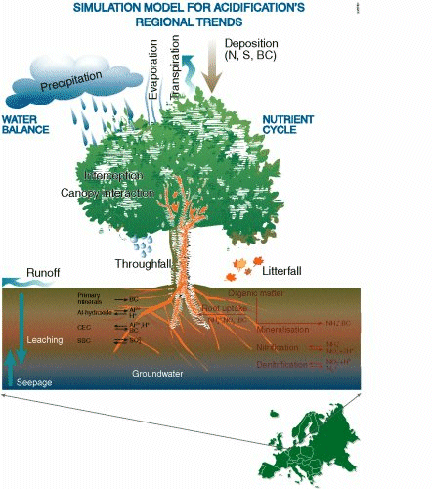

SMART2 (Kros et al., 1995) is a simple one-compartment soil acidification and nutrient cycling model that includes the major hydrological and biogeochemical processes in the vegetation, litter and mineral soil. Apart from pH, the model also predicts changes in aluminium (Al3+), base cation (BC), nitrate (NO3-) and sulphate (SO42-) concentrations in the soil solution and solid phase characteristics depicting the acidification status, i.e. carbonate content, base saturation and readily available Al content. The SMART2 model is an extension of the dynamic soil acidification model SMART (De Vries et al. 1989). The major extensions in SMART2 are the inclusion of a nutrient cycle and an improved modelling of hydrology. The SMART2 model consists of a set of mass balance equations, describing the soil input-output relationships, and a set of equations describing the rate-limited and equilibrium soil processes.

The soil solution chemistry in SMART2 depends solely on the net element input from the atmosphere (the product of deposition and filtering factor) and groundwater (seepage), canopy interactions (foliar uptake, foliar exudation), geochemical interactions in the soil (CO2 equilibria, weathering of carbonates, silicates and/or Al-hydroxides, SO42- sorption and cation exchange) and a complete nutrient cycle (litterfall, mineralisation, root uptake, nitrification and denitrification). Processes that are not taken into account, are: (i) N fixation and NH4+ adsorption, (ii) uptake, immobilization and reduction of SO42-, (iii) complexation of Al3+ with OH-, SO42- and RCOO- and (iv) interaction between the soil solution and the vegetation. Growth of the vegetation and litterfall are modelled by a logistic growth function, which acts as a forcing function. Nutrient uptake is only limited when there is a shortage in the soil solution. Soil interactions are either described by simple rate-limited (zero-order) reactions (e.g. uptake and silicate weathering) or by equilibrium reactions (e.g. carbonate and Al-hydroxide weathering and cation exchange). Influence of environmental factors such as pH on rate-limited reactions and rate-limitation of weathering and exchange reactions are ignored. Solute transport is described by assuming complete mixing of the element input within one homogeneous soil compartment with a constant density and a fixed depth (at least the root zone). Since SMART2 is a single layer soil model, neglecting vertical heterogeneity, it predicts the concentration of the soil water leaving the root zone. The annual water flux percolating from this layer is taken equal to the annual precipitation, which must be specified as a model input. The time step of the model is one year, so seasonal variations are not considered. De Vries et al. (1989) provide a justification of the various assumptions and simplifications.